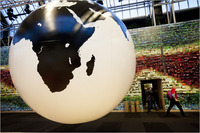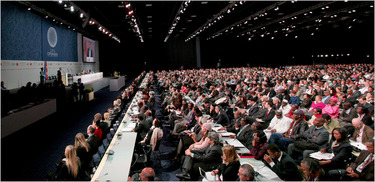Climate Talks Open With Calls for Urgent Action
December 7, 2009
COPENHAGEN — A much-anticipated global meeting of nearly 200 nations — all seeking what has so far been elusive common ground on the issue of climate change — began here on Monday with an impassioned airing of what leaders here called the political and moral imperatives at hand.
Written by TOM ZELLER Jr., The New York Times

A globe hung at a conference center in Copenhagen where climate change is to be discussed.
Click here to view larger image.
COPENHAGEN — A much-anticipated global meeting of nearly 200 nations — all seeking what has so far been elusive common ground on the issue of climate change — began here on Monday with an impassioned airing of what leaders here called the political and moral imperatives at hand.
“The clock has ticked down to zero,” said the United Nations’ climate chief, Yvo de Boer. “After two years of negotiation, the time has come to deliver.”
From now until Dec. 18, delegates will try to hammer out some of the most vexing details involved in the pursuit of a global climate accord.
While the critical action will unfold much later in the process, when higher-level ministers and, ultimately, heads of state arrive, the opening day of the conference was an opportunity for the United Nations to nurture a sense of mission and for delegates to begin staking out their positions.
Among the most difficult hurdles, many participants acknowledged throughout the day, are achieving adequate cuts in greenhouse gas emissions — particularly from big polluters like the United States and China.
So, too, are securing commitments from wealthy nations to deliver what could ultimately be hundreds of billions of dollars in financing to poor countries, which argue that they are ill equipped to deal with a problem they did little to create.
Several countries announced new emissions goals in the days leading up to the meeting, including China, Brazil, the United States, India and South Africa — although many participants have noted that the targets are far too low to keep rising temperatures in check in coming decades.
The pledges so far are “not going to get us as far we need to go, to really stay within the two-degree limit,” said Koko Warner, an observer with the United Nations University in Bonn, Germany. He was referring to scientists’ recommendations that temperature increases be capped at two degrees Celsius (3.6 degrees Fahrenheit) above pre-industrial levels.
“We don’t want to admit it, because the consequences are so bad,” she said.
Still, speakers at the conference’s opening plenary session — which began with a video appeal from children across the world to save them from what looked like an apocalyptic future of deserts and rising seas — were clearly aiming to spur negotiators forward.
After several hundred delegates and observers settled inside the main conference hall of the Bella Center to music from a trumpeter, a harpist and the Danish Girls Choir, Connie Hedegaard, the Danish minister presiding over the conference, noted the recent string of emissions commitments by various countries.
“Every positive announcement will improve our chances of staying below the two degrees Celsius target,” she said. “But as we all know only too well, we are not there yet.”
“This goes for financing as well,” Ms. Hedegaard said, noting that arriving at a consensus on that issue “may be an even bigger challenge” than emissions cuts.
Rajendra K. Pachauri, the chairman of the Intergovernmental Panel on Climate Change, spoke before delegates of the urgent need for action. And, alluding to a recent controversy over e-mail messages between scientists hacked from a university computer server, he had pointed remarks for those who “find it difficult to accept” climate change science.
Climate change skeptics have argued that the e-mail shows that the evidence for global warming is less unequivocal than scientists assert.
But Dr. Pachauri ticked off a list of trends that robustly reflect the warming of the global climate. “Internal consistency from multiple lines of evidence strongly supports the work of the scientific community, including the individuals singled out in these e-mail messages,” he said.
Both inside and outside the plenary session, the mood among negotiators and other participants was one of cautious optimism. Alden Meyer, who directs climate policy for the Union of Concerned Scientists, said he was encouraged that the meeting appeared to have nudged previously reluctant nations to begin offering up emissions cuts.
“It has focused attention and gotten all the major players to put their initial offers on the table,” Mr. Meyer said. “I think that’s good news.”
Still, negotiators who have spent the last year working out the technical details of a potential treaty are now coming up hard against political pressures at much higher levels that will ultimately shape any agreement.
The challenge, Mr. Meyer said, will be getting parties to “rise above the politics as usual” that threatens to bog down the process.
Jonathan Pershing, the State Department’s special climate envoy, who represented the United States at the opening plenary, said he saw strong signs that the conference would prove critical in getting traction on curbing emissions and helping poor countries that are urgently threatened by climate change — particularly given the decision by more than 100 leaders, including President Obama, to attend.
He said he saw no indication that efforts could be blunted by Saudi Arabia and other countries that have cited the e-mail flap in challenging climate findings.
At a subsequent news conference, however, Mr. Pershing faced questions from European reporters about the adequacy of Mr. Obama’s plan for emissions cuts, which is roughly parallel to what is laid out in legislation in the House and Senate.
Mr. Pershing said the American proposal — which calls for a reduction in emissions by 30 percent from 2005 levels by 2025, 42 percent by 2030 and 80 percent by 2050 — was in keeping with cuts that scientists say would avert the worst dangers, but only if all countries, including emerging economies, did their part.
“It’s a vision that moves the United States down the curve of greenhouse gas emissions at a level that no other country has even begun to seriously contemplate,” Mr. Pershing said. While the United States produces one-fifth of worldwide greenhouse emissions, he noted, four-fifths are coming from elsewhere.
“Unless the world can combine its efforts, we won’t solve the problem,” he said.
Outside the Bella Center, calls were growing for conference participants to overcome their differences and deliver results in coming days.
An open letter from a coalition of groups, including Friends of the Earth, the Third World Network and others, accused Danish leaders of “undemocratic practices” and of “convening small and exclusive groups of countries before the Copenhagen meeting.”
The assertion is a reference to rumors that “alternate” treaties are being readied by some big players, including conference organizers, should efforts to resolve differences on the current text prove fruitless.
Meanwhile, 56 newspapers around the world published the same editorial calling for “decisive action” in Copenhagen.
“In scientific journals the question is no longer whether humans are to blame, but how little time we have got left to limit the damage,” read the editorial, which was widely distributed in a campaign led by Britain’s Guardian newspaper. “Yet so far the world’s response has been feeble and half-hearted.”
Continued inaction will ravage the planet and wreak havoc on economies and livelihoods, the editorial’s authors warned.
“The politicians in Copenhagen have the power to shape history’s judgment on this generation: one that saw a challenge and rose to it, or one so stupid that we saw calamity coming but did nothing to avert it,” the editorial said. “We implore them to make the right choice.”
![]()
![]()
Related Stories
![]()
Fair Use Notice
This site contains copyrighted material the use of which has not always been specifically authorized by the copyright owner. We are making such material available in our efforts to advance understanding of environmental, political, human rights, economic, democracy, scientific, and social justice issues, etc. We believe this constitutes a "fair use" of any such copyrighted material as provided for in section 107 of the US Copyright Law. In accordance with Title 17 U.S.C. Section 107, the material on this site is distributed without profit to those who have expressed a prior interest in receiving the included information for research and educational purposes. For more information go to: http://www.law.cornell.edu/uscode/17/107.shtml. If you wish to use copyrighted material from this site for purposes of your own that go beyond "fair use", you must obtain permission from the copyright owner.
